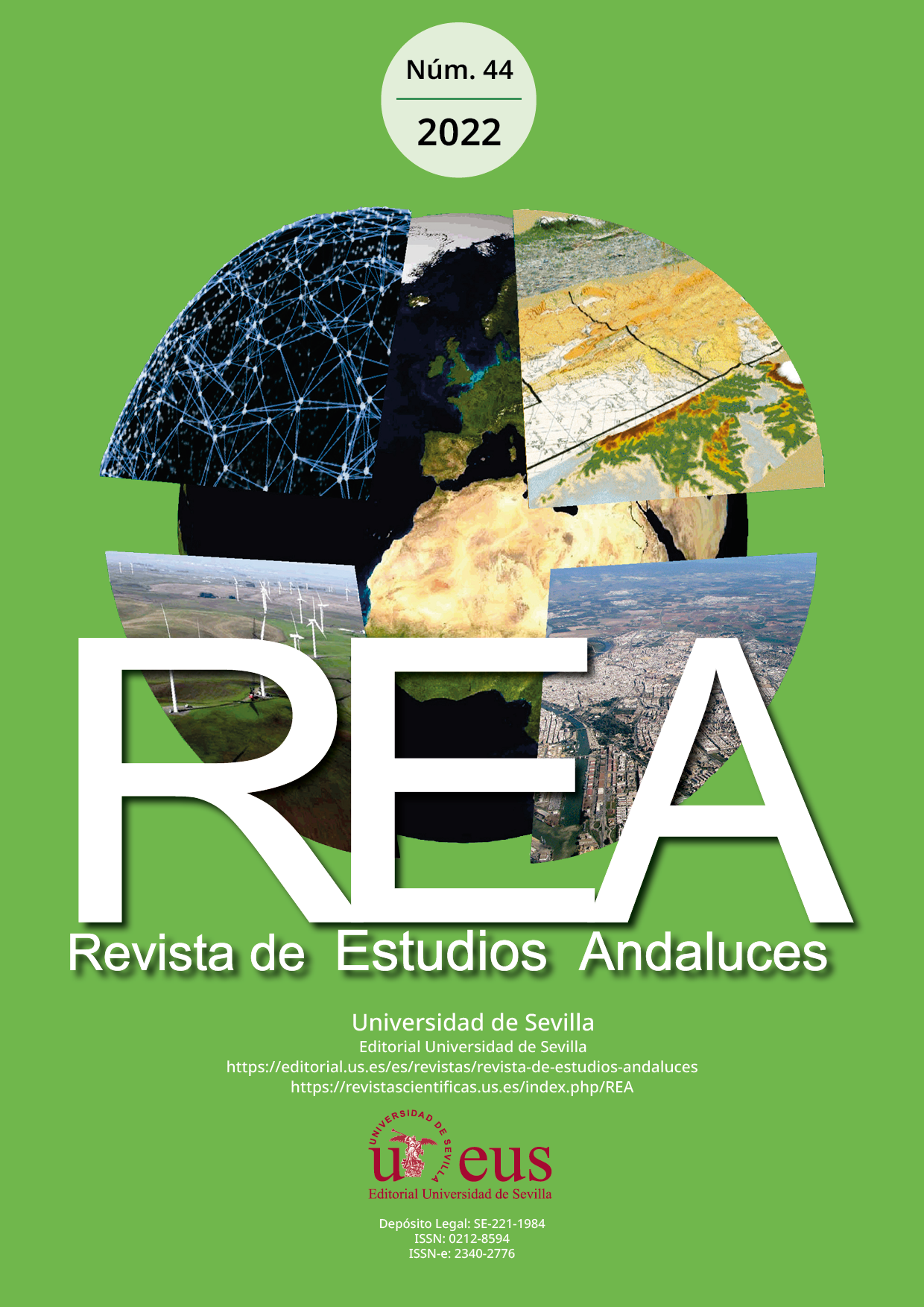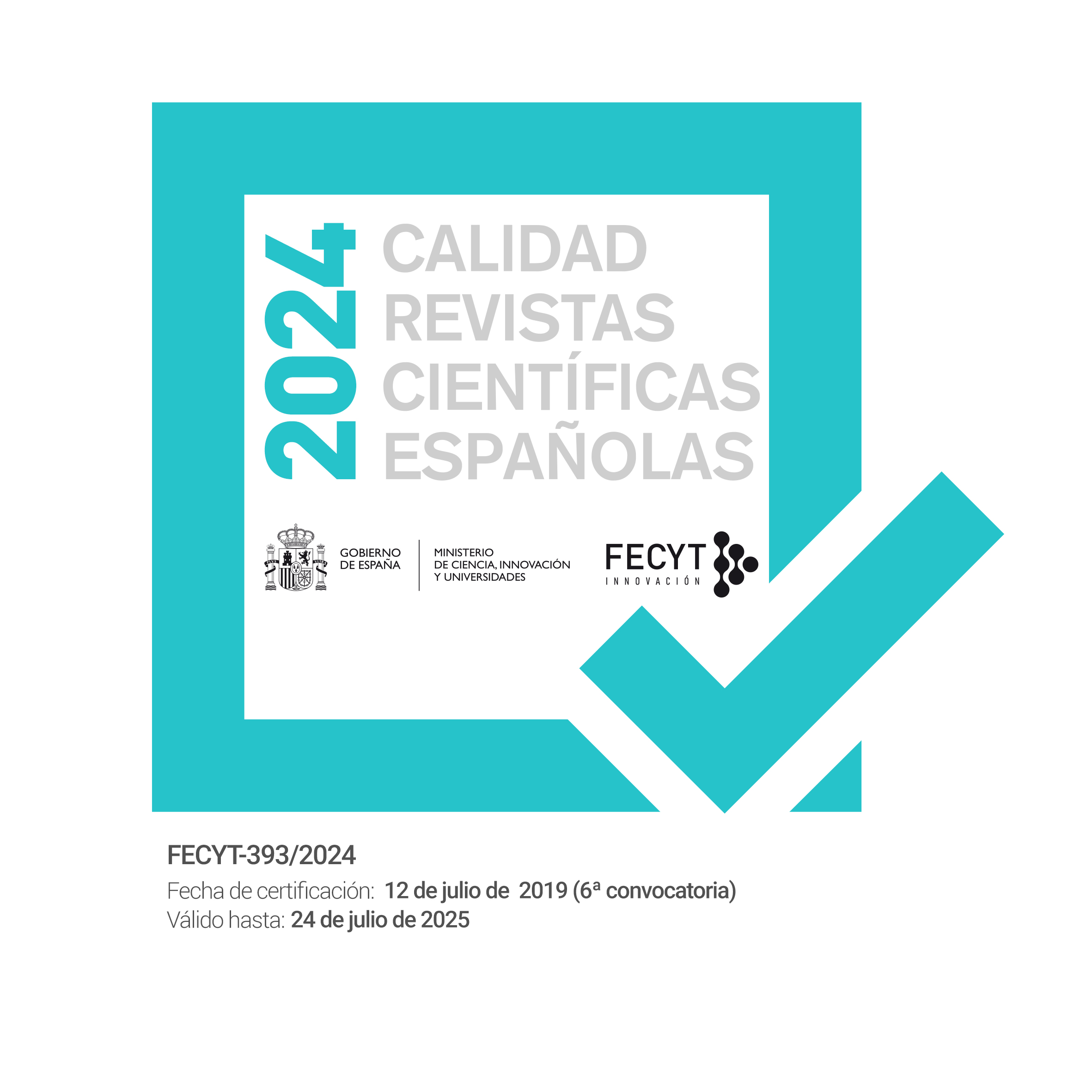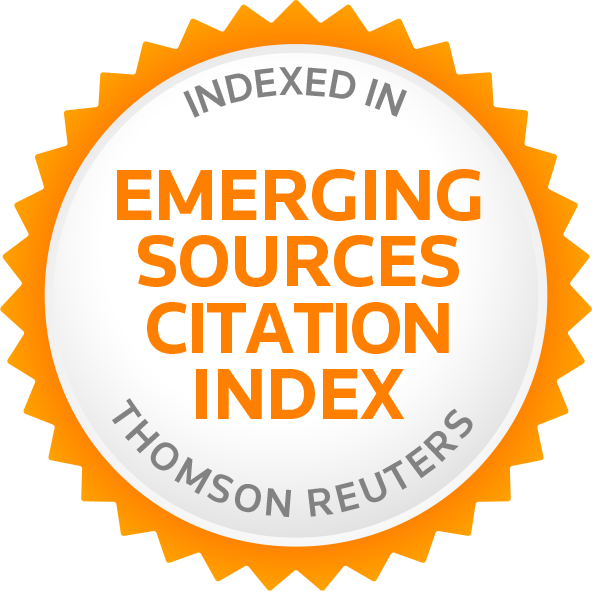Accesibilidad espacio-temporal al transporte público y a los lugares de ocio nocturno: estudio de caso de la juventud en Alcobendas
DOI:
https://doi.org/10.12795/rea.2022.i44.03Palabras clave:
Accesibilidad espacial, Justicia espacial, General Transit Feed Specification, Juventud, Ocio nocturnoResumen
En el contexto de las investigaciones actuales sobre accesibilidad intraurbana, este trabajo persigue caracterizar el acceso de la población juvenil a la red de transporte público por motivo de ocio nocturno y medir las desigualdades, y posibles inequidades socio-espaciales, existentes en la ciudad de Alcobendas (Comunidad de Madrid, España). Metodológicamente se ha recurrido, entre otros, a los datos General Transit Feed Specification, que ofrecen innovadoras posibilidades analíticas, y al tratamiento con Sistemas de Información Geográfica y técnicas de estadística inferencial. Los resultados permiten desvelar, de forma muy precisa temporal y espacialmente, una cobertura amplia de ese grupo de población y que prioriza las zonas con mayor demanda potencial y de menor renta per cápita, aunque también revelan problemas, particularmente de frecuencia, en determinados periodos nocturnos y zonas.
Descargas
Citas
Aramayona, B., Romón, J., Gómez-Ullate, J., Fuentes, D., Sánchez, M., & Nofre, J. (2020). Geografías de la ciudad nocturna: Análisis comparativo y aplicado del ocio nocturno joven en Madrid, Barcelona y Lisboa. Centro Reina Sofía sobre Adolescencia y Juventud. https://doi.org/10.5281/zenodo.4696216
Arranz-López, A., Soria-Lara, J.A & Pueyo-Campos, A. (2019). Social and spatial equity effects of non-motorised accessibility to retail, Cities, 86, 71–82. https://doi.org/10.1016/j.cities.2018.12.012
Banister, D. (2018). Inequality in transport. Alexandrine Press.
Bok, J., & Kwon, Y. (2016). Comparable measures of accessibility to public transport using the general transit feed specification. Sustainability, 8(3), 224. https://doi.org/10.3390/su8030224
Colque, A., Valdivia, R., Navarrete, M., & Aracena, S. (2019). Un sistema de información geográfico para el transporte público basado en el estándar GTFS realtime. Ingeniare. Revista Chilena de Ingeniería, 29(1), 51-62
Concejalía de Tráfico, Movilidad y Transportes (2019). Plan de Movilidad Urbana Sostenible. Ayuntamiento de Alcobendas.
Consorcio Regional de Transportes de Madrid. (2015). Plan Estratégico de Movilidad Sostenible de la Comunidad de Madrid (2013-2025). Consejería de Transportes, Infraestructuras y Vivienda.
Cresswell, T. (2006). The right to mobility: The production of mobility in the courtroom. Antipode, 38(4), 735-754. https://doi.org/10.1111/j.1467-8330.2006.00474.x
Crosnoe, R., & Johnson, M. K. (2011). Research on adolescence in the twenty-first century. Annual Review of Sociology, 37, 439-460. https://doi.org/10.1146/annurev-soc-081309-150008
Curtis, A., Droste, N., Coomber, K., Guadagno, B., Mayshak, R., Hyder, S., Hayley, A., & Miller, P. (2019). Off the rails—Evaluating the nightlife impact of Melbourne, Australia’s 24–h public transport trial. International Journal of Drug Policy, 63, 39-46. https://doi.org/10.1016/j.drugpo.2018.10.006
Delbosc, A., & Currie, G. (2011). Using Lorenz curves to assess public transport equity. Journal of Transport Geography, 19(6), 1252-1259. https://www.jtrangeo.2011.02.008
Dirección General de Tráfico. (2018). Tablas estadísticas. Dirección General de Tráfico. http://www.dgt.es/es/seguridad-vial/estadisticas-e-indicadores/censo-conductores/tablas-estadisticas/
Farber, S., & Fu, L. (2017). Dynamic public transit accessibility using travel time cubes: Comparing the effects of infrastructure (dis)investments over time. Computers, Environment and Urban Systems, 62, 30-40. https:// doi.org/10.1016/j.compenvurbsys.2016.10.005
Ferreira de Gois, M. P. (2018). Movilidad nocturna: Estudio sobre los circuitos urbanos nocturnos en la ciudad de Rio de Janeiro. Universitas Humanística, 85 (enero - junio), 263 - 291. https://doi.org/10.11144/Javeriana.uh85.mnes
García Palomares, J. C. (2000). La medida de la accesibilidad. Estudios de Construcción y Transportes, 88, 95 – 110.
Geurs, K. T., & van Wee, B. (2004). Accessibility evaluation of land-use and transport strategies: Review and research directions. Journal of Transport Geography, 12(2), 127-140. https:// doi.org/10.1016/j.jtrangeo.2003.10.005
Giuffrida, N., Ignaccolo, M., Inturri, G., Rofè, Y., & Calabrò, G. (2017). Investigating the correlation between transportation social need and accessibility: The case of Catania. Transportation Research Procedia, 27, 816-823. https:// doi.org/10.1016/j.trpro.2017.12.122
Gramacki, P., Woźniak, S., & Szymański, P. (2021). gtfs2vec - Learning GTFS Embeddings for comparing Public Transport Offer in Microregions. Paper presented at the GeoSearc, 21, 5-12. https://doi.org/10.1145/3486640.3491392
Griffin, G. P., & Sener, I. N. (2016). Public transit equity analysis at metropolitan and local scales: A focus on nine large cities in the US. Journal of Public Transportation, 19(4), 126-143. https:// doi.org/10.5038/2375-0901.19.4.8
Gutiérrez, J. (2018). Big data y nuevas geografías: La huella digital de las actividades humanas. Documents D’Anàlisi Geogràfica, 64(2), 195-217. https://doi.org/10.5565/rev/dag.526
Habitat International Coalition. (2013). Carta mundial por el derecho a la ciudad. Cuadernos Geográficos, 52, 368-380.
Hadas, Y. (2013). Assessing public transport systems connectivity based on google transit data. Journal of Transport Geography, 33, 105-116. https:// doi.org/10.1016/j.jtrangeo.2013.09.015
Hadas, Y. & Ranjitkar, P. (2012). Modeling public-transit connectivity with spatial quality-of-transfer measurements. Journal of Transport Geography, 22, 137-147. https://doi.org/10.1016/j.jtrangeo.2011.12.003
Hadfield, P., & Measham, F. (2009). Shaping the night: How licensing, social divisions and informal social controls mould the form and content of nightlife. Crime Prevention and Community Safety: An International Journal, 11(3), 219-234. https:// doi.org/10.1057/cpcs.2009.15
Hansen, W. G. (1959). How accessibility shapes land use. Journal of the American Institute of Planners, 25(2), 73-76. https:// doi.org/10.1080/01944365908978307
Harvey, D. (1977). Urbanismo y desigualdad social. Siglo XXI de España.
Holmgren, J. (2007). Meta-analysis of public transport demand. Transportation Research Part A, 41(10), 1021-1035. https:// doi.org/10.1016/j.tra.2007.06.003
Ingram, D. R. (1971). The concept of accessibility: A search for an operational form. Regional Studies, 5(2), 101-107. https:// doi.org/10.1080/09595237100185131
Jaramillo, C., Lizárraga, C., & Grindlay, A. L. (2012). Spatial disparity in transport social needs and public transport provision in Santiago de Cali (colombia). Journal of Transport Geography, 24, 340-357. https:// doi.org/10.1016/j.jtrangeo.2012.04.014
Johnson, M. K., Crosnoe, R., & Elder, G. H. (2011). Insights on adolescence from a life course perspective. Journal of Research on Adolescence, 21(1), 273-280. https:// doi.org/10.1111/j.1532-7795.2010.00728.x
Jones, S. R. (1981). Accessibility measures: a literature review. Transport and Road Research Laboratory.
Kaeoruean, K., Phithakkitnukoon, S., Getachew Demissie, M., Kattan, L., & Ratti, C. (2020). Analysis of demand–supply gaps in public transit systems based on census and GTFS data: a case study of Calgary, Canada. Public Transport, 12, 483-516. https://doi.org/10.1007/s12469-020-00252-y
Karner, A. (2018). Assessing public transit service equity using route-level accessibility measures and public data. Journal of Transport Geography, 67(C), 24-32. https://doi.org/10.1016/j.jtrangeo.2018.01.005
Kwan, M. (2013). Beyond space (as we knew it): Toward temporally integrated geographies of segregation, health, and accessibility. Annals of the Association of American Geographers, 103(5), 1078-1086. https:// doi.org/10.1080/00045608.2013.792177
Lei, T. L., & Church, R. L. (2010). Mapping transit-based access: Integrating GIS, routes and schedules. International Journal of Geographical Information Science, 24(2), 283-304. https:// doi.org/10.1080/13658810902835404
Litman, T. (2017). Evaluating transportation equity. Victoria Transport Policy Institute.
Liu, L., & Miller, H. (2021). Measuring risk of missing transfers in public transit systems using high-resolution schedule and real-time bus location data. Urban Studies Journal Limited, 58(15), 1-17. https://doi.org/10.1177/0042098020919323
Lucas, K. (2012). Transport and social exclusion: Where are we now? Transport Policy, 20, 105-113. https:// doi.org/10.1016/j.tranpol.2012.01.013
Martens, K. (2012). Justice in transport as justice in accessibility: Applying Walzer’s “spheres of justice”to the transport sector. Transportation, 39(6), 1035–1053. https://doi.org/10.1007/s11116-012-9388-7
Martens, K. (2019). Why Accessibility Measurement is Not Merely an Option, but an Absolute Necessity. In L. Bertolini, & N. Pinto (Eds.), Designing Accessibility Instruments Lessons on Their Usability for Integrated Land Use and Transport Planning Practices (pp. 37-51). Routledge. https://doi.org/10.4324/9781315463612-4
McHugh, B. (2013). Pioneering open data standards: The GTFS story. En B. Goldstein, & L. Dyson (eds.), Beyond transparency. Open data and the future of civic innovation (pp. 125-135). American Press.
Measham, F. (2008). The turning tides of intoxication: Young people’s drinking in Britain in the 2000s. Health Education, 108(3), 207-222. https:// doi.org/10.1108/09654280810867088
Mecca, M. (2018). Descubriendo el ocio nocturno urbano. Primeras experiencias entre adolescentes en Barcelona. Universitat Autónoma de Barcelona. http://hdl.handle.net/10803/462061
Mercadé, J., Magrinyà, F., & Cervera, M. (2020). Revelando las centralidades del transporte público mediante SIG y GTFS: Una propuesta de reequilibrio urbano para el área metropolitana de Barcelona. GeoFocus. Revista Internacional De Ciencia Y Tecnología de la Información Geográfica, 25, 27-46. https:// doi.org/10.21138/GF.657
Morang, M. (2013). Add GTFS to a Network Dataset. ArcGIS Hub. https://hub.arcgis.com/content/transanalytics::add-gtfs-to-a-network-dataset/about
Moreno Jiménez, A. (2010). Justicia ambiental. Del concepto a la aplicación en análisis de políticas y planificación territoriales. Scripta Nova, 14, 310-322. http://www.ub.es/geocrit/sn/sn-316.html
Moreno Jiménez, A., Cañada Torrecilla, R., Martínez Suárez, P., Vidal Domínguez, M. J. & Palacios García, A. (2022): How much inequality in exposure to high PM10 pollution is too much to be considered environmentally unfair? An assessment for vulnerable groups in two major Spanish cities, Boletín de la Asociación de Geógrafos Españoles, 92, https://doi.org/10.21138/bage.3173
Morris, J.M., Dumble, P.L. & Wigan, M.R. (1979). Accessibility indicators for transport planning. Transportation Research A, 13, 91-109. https://doi.org/10.1016/0191-2607(79)90012-8
Moseley, M. J. (1979). Accessibility: The rural challenge. Methuen.
Moya-Gómez, B., Stępniak, M., García-Palomares, J. C., Frías-Martínez, E., & Gutiérrez, J. (2021). Exploring night and day socio-spatial segregation based on mobile phone data: The case of Medellin (Colombia). Computers, Environment and Urban Systems, 89, 101675. https:// doi.org/10.1016/j.compenvurbsys.2021.101675
Öberg, S. (1976). Methods of describing physical access to supply points. Stockholm: Royal University of Lund, Lund Series in Geography, Nº 43.
O’Sullivan, D., Morrison, A., & Shearer, J. (2000). Using desktop GIS for the investigation of accessibility by public transport: An isochrone approach. International Journal of Geographical Information Science, 14(1), 85-104. https:// doi.org/10.1080/136588100240976
Park, J. & Goldberg, D.W. 2021. A review of recent spatial accessibility studies that benefitted from advanced geospatial information: multimodal transportation and spatiotemporal disaggregation. ISPRS International Journal of Geo-Information, 10, 532. https://doi.org/10.3390/ijgi10080532
Paulley, N., Balcombe, R., Mackett, R., Titheridge, H., Preston, J., Wardman, M., Shires, J., & White, P. (2006). The demand for public transport: The effects of fares, quality of service, income and car ownership. Transport Policy, 13(4), 295-306. https:// doi.org/10.1016/j.tranpol.2005.12.004
Pedrero-García, E. (2018). Nightlife and alcohol consumption among youths: The botellón phenomenon in Spain. SAGE Open, 8(3), 1-7. https:// doi.org/10.1177/2158244018800903
Pereira, R. H. M. (2018). Distributive justice and transportation equity: Inequality in accessibility in Rio de Janeiro. https://doi.org/10.31237/osf.io/d2qvm
Plyushteva, A., & Boussauw, K. (2020). Does night-time public transport contribute to inclusive night mobility? exploring sofia’s night bus network from a gender perspective. Transport Policy, 87, 41-50. https:// doi.org/10.1016/j.tranpol.2020.01.002
Prats Ferret, M., Ortiz Guitart, A., & Baylina Ferré, M. (2014). Procesos de apropiación adolescente del espacio público: otra cara de la renovación urbanística en Barcelona. Boletín de la Asociación de Geógrafos Españoles, 65, 37-57. https://doi.org/10.21138/bage.1742
Pyrialakou, V. D., Gkritza, K., & Fricker, J. D. (2016). Accessibility, mobility, and realized travel behavior: Assessing transport disadvantage from a policy perspective. Journal of Transport Geography, 51, 252-269. https://doi.org/10.1016/j.jtrangeo.2016.02.001
Romanillos, G., García-Palomares, J. C., Moya-Gómez, B., Gutiérrez, J., Torres, J., López, M., Cantú-Ros, O. G., & Herranz, R. (2021). The city turned off: Urban dynamics during the COVID-19 pandemic based on mobile phone data. Applied Geography, 134, 102524. https:// doi.org/10.1016/j.apgeog.2021.102524
Salado García, M.J. (2012). Localización de los equipamientos colectivos, accesibilidad y bienestar social. En J. Bosque Sendra & A. Moreno Jiménez (Eds.), Sistemas de información geográfica y localización óptima de instalaciones y equipamientos. RA-MA, 41-72.
Scagnolari, S., Walker, J., & Maggi, R. (2015). Young drivers’ night-time mobility preferences and attitude toward alcohol consumption: A hybrid choice model. Accident Analysis and Prevention, 83, 74-89. https:// doi.org/10.1016/j.aap.2015.07.002
Smith, D. M. (1980). Geografia humana. Oikos-Tau.
Stanley, J., & Stanley, J. (2017). The importance of transport for social inclusion. Social Inclusion, 5(4), 108-115. https://doi.org/10.17645/si.v5i4.1289
Stępniak, M., Moya-Gómez, B., & Gutiérrez Puebla, J. (2018). Causas de la baja accesibilidad en áreas urbanas (Identification of causes of low urban accessibility). [Comunicación en congreso]. XIII Congreso de Ingeniería del Transporte.
Stępniak, M., Pritchard, J. P., Geurs, K. T., & Goliszek, S. (2019). The impact of temporal resolution on public transport accessibility measurement: Review and case study in Poland. Journal of Transport Geography, 75, 8-24. https:// doi.org/10.1016/j.jtrangeo.2019.01.007
Sun, Y., & Thakuriah, P. (2021). Public transport availability inequalities and transport poverty risk across England. Environment and Planning B, 48(9), 2775-2789. https://doi.org/10.1177/2399808321991536
Tao, S., Rohde, D., & Corcoran, J. (2014). Examining the spatial-temporal dynamics of bus passenger behaviour using smart card data and the flow-comap. Journal of Transport Geography, 41, 21-36. https://doi.org/10.1016/j.jtrangeo.2014.08.006
Tarar, A., Mukherjee, D., & Rao, K. R. (2021). Development of bus transit system control measures with open transit data. Scientific Journal of Silesian University of Technology, 111, 169-180. https://doi.org/10.20858/sjsutst.2021.111.15
Web, A., Kumar, P., & Khani, A. (2020). Estimation of passenger waiting time using automatically collected transit data. Public Transport, 12, 299–311. https://doi.org/10.1007/s12469-020-00229-x
Wong, J. (2013). Leveraging the General Transit Feed Specification for efficient transit analysis. Transportation Research Record, 2338(1), 11-19. https://doi.org/10.3141/2338-02
Publicado
Cómo citar
Número
Sección
Licencia
Derechos de autor 2022 Revista de Estudios Andaluces

Esta obra está bajo una licencia internacional Creative Commons Atribución-NoComercial-CompartirIgual 4.0.
La edición electrónica de la Revista de Estudios Andaluces se ofrece en acceso abierto desde el número 28 publicado en 2011 hasta la actualidad. Las ediciones impresa y electrónica de esta Revista son editadas por la Editorial de la Universidad de Sevilla, siendo necesario citar la procedencia en cualquier reproducción parcial o total.
La Revista de Estudios Andaluces no cobra tasas por el envío de trabajos, ni tampoco cuotas por la publicación de sus artículos. La Revista es gratuita desde el momento de la publicación de cada número y sus contenidos se distribuyen con la licencia “CreativeCommons Atribución-NoComercial-SinDerivar 4.0 Internacional” , que permite al usuario de la Revista de Estudios Andaluces criterios que cumplen con la definición de open access de la Declaración de Budapest en favor del acceso abierto. Puede consultar desde aquí la versión informativa y el texto legal de la licencia. Esta circunstancia ha de hacerse constar expresamente de esta forma cuando sea necesario.







